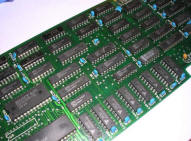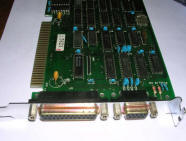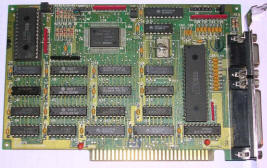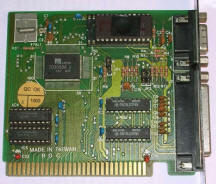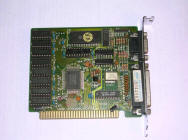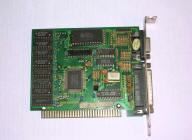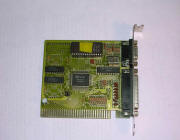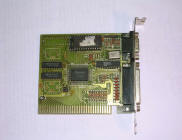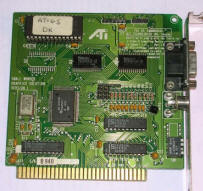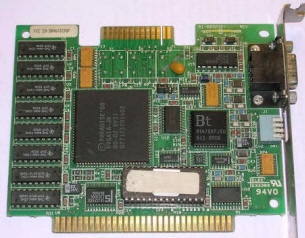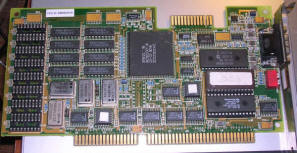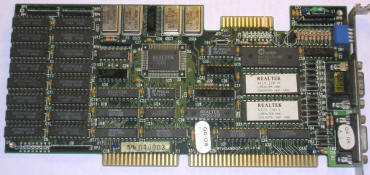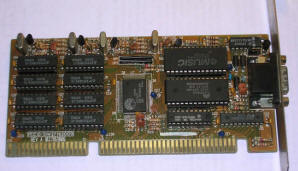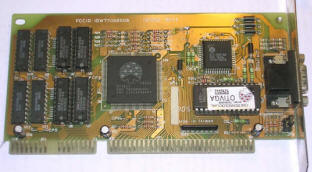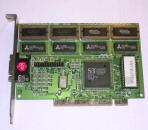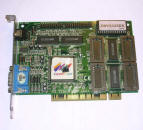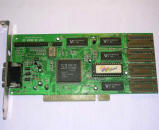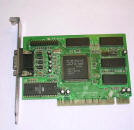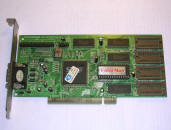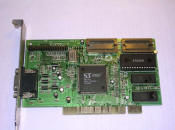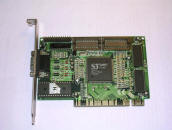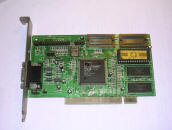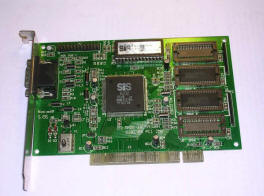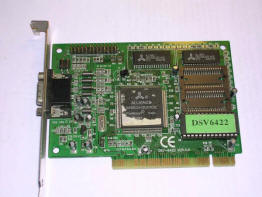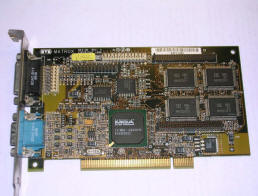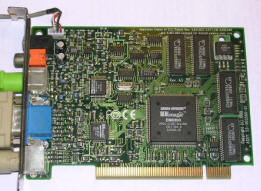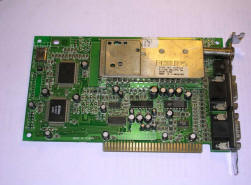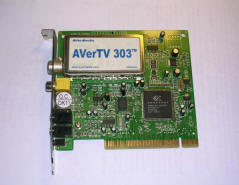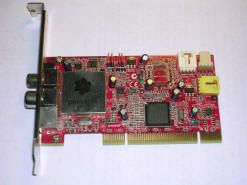Graphics boards
PCs had to display text and graphics some way. First, a
MDA board was used known as Monochrome Display Adapter. MDA could only
display text, using font from ROM memory located on board. For graphics,
a CGA (Colour Graphics Adapter) board had to be used which could display
in 4 colours (of 8) and in a bit higher resolution in monochrome.
The problem with MDA was its fixed font, while CGA had poor resolution.
As solution, a Hercules graphics card (HGC) was developed. Hercules
allowed to put text using on-ROM font in MDA-like mode, or use the same
mode for graphics, giving 720x348 resolution for monochrome graphics.
This way, if e.g. foreign characters had to be displayed and they were
not present in ROM, it was even possible to "patch" the text mode by the
cost of processing speed.
Both IBM and other companies released other adapters to add support for
better, faster and more colorful video. A
PGC -
Professional Graphics Controller - was in fact a computer on a board
giving 640x480 resolution in 256 colours of a 2048-colour pallette.
IBM's next move was EGA (Enhanced Graphics Adapter) could reach 640x350
with 16 colours.
Then, capabilities of TTL displays at IBM ended. Later 8514 and VGA
boards used analog monitors. VGA - Video Graphics Array (this time
Array - a chip, not a whole board), could get 640x480 in 16 colours as
well as 320x200 at 256. Later expansions in video memory and chipset
access times allowed to have better resolutions like 800x600 at 256
colours (SVGA - Super VGA).
For along time even in 1990s there was an opinion that for an office
computer it's not needed to use VGA - Hercules was totally OK. With
Windows 3.x getting popular VGA gained its popularity and in mid-1990s a
typical PC clone contained a 16-bit ISA VGA board, usually with Trident
chipset. 256kB or 512kB of video RAM was totally enough, giving 800x600
at 256 colours what was totally OK when operating in Windows 3.x.
Nevertheless, most middle-end monitors could not operate with better
resolutions (or 1024x768 in interlaced mode).
For information about boards, I recommend to visit a VGA Museum website, they have a large collection.
For Taiwanese PC clones, MDA was rarely used. Here we have a Hercules board with built-in ROM, made around discrete chips with only small share of VLSI circuits. As usual, it has parallel port for printer, being a Video and printer adapter. The board is quite large and fills a whole standard of full-height full-length board.
Protons and Winbonds were the most popular Hercules clones, being used in PC clones even in 1990s. They were imported and sold with or without local character ROM. Similar boards have been made since mid-1980s even in 1992. More high-end models had jumpers for disabling and setting printer port, while cheaper ones had it hard-wired.
| MCGVP MCG2502 was a CGA-compatible board also
used in PC clones. It has localized character ROM and printer
port, some versions have a TV-OUT connector used in CGA modes.
What's more interesting, according to
VGA Legacy this chipset was used in imported Mazovia
computers. This board is made the way that it can use both 4164 as well as two 4464 chips for video memory. |
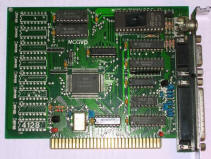 |
| Genoa EGA clone with 256kB of RAM. In 1990s
there were lots of EGA and VGA clones with more-or-less similar
compatibility. This one is EGA, with two (?) composite outputs
as well as light pen connector. I don't know about this one, but Genoa was known in VGA world that they included some undocumented modes here and there, and some software included workarounds and drivers to make them available. |
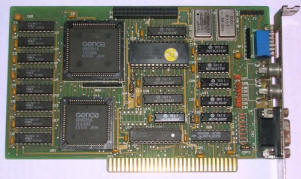 |
| Octek EVGA-8 was an early-1990s VGA and EGA-compatible board. VGA display can be connected. |
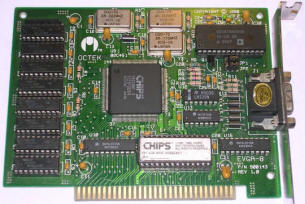 |
| For 16-bit systems there was also a 16-bit
version of Paradise VGA board. And also it was one of the
cheapest way to get 800x600. An earlier unit was
WD90C00, with similar capabilities and
BIOS. |
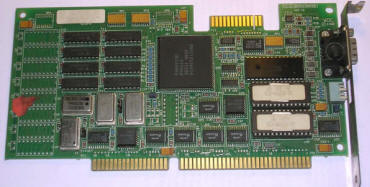 |
Simultaneously, Oak Technology released their own VGA boards with their chips. Here we have two boards, from 1991 and 1992, with typical (800x600) VGA capabilities.
|
|
|
All-time popular boards, Trident TVGAs. Their popularity
started around 1992 or 93, and they were used even in 96 in low-end
systems. There were lots of boards containing TVGA chips, with 256, 512
or 1024kB of video RAM. Many of these boards had a segment of 3 jumpers
which allowed to run them in 8-bit slot.
A typical problem with these boards was the dependency on BIOS video
settings - if something was wrong there, it rendered the picture in
grayscale. Many Trident boards also used a monitor detection quite
incompatible with modern TTL signals on detection lines, and its fault
also resulted in grayscale picture.
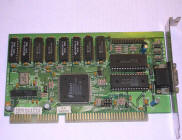 TVGA8900 with 1MB of VRAM |
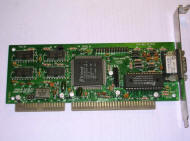 TVGA9000i with 256kB of VRAM, the most popular one |
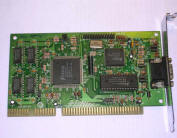 TVGA9000C with 512kB of VRAM |
 Similar TVGA900C, also 512kB |
Cirrus Logic was competing with Trident these times. They also made similar boards, and their VGA boards were popular too. There was an opinion that some Cirrus boards are a bit faster than Tridents when it comes to re-drawing a complete screen in higher resolutions like 800x600.
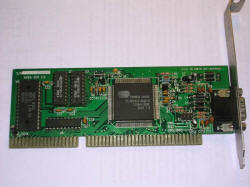 CL-GD5401 with 256kB of VRAM |
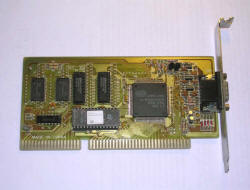 CL-GD5402 with 512kB. |
| I have no idea what this thing is. The chipset was made by HMC, it has 512kB of VRAM and requires parity for it. It was made around 1994 and probably is not very fast. |
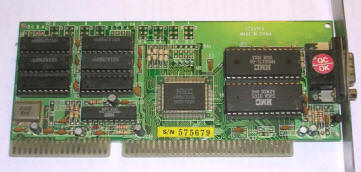 |
Most of ISA chipsets were improved and used in VLB (VESA Local bus) boards too. VLB slots lived shortly in 486 computers, mostly because of forcing synchronization with CPU clock. Also, technical difficulties arose when adding one more slot to 16-bit ISA. Here we can see two boards, one is a typical video-only board, the second is a "combo" board - it has a video board, serial and parallel port controller as well as IDE and FDD controllers in a single board.
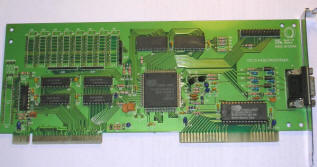 Cirrus CL-GD5424 with 512kB of VRAM |
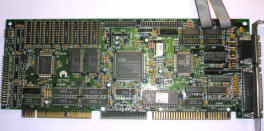
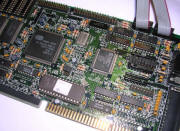 Octek Combo board with Cirrus CL-GD5426, 256kB of VRAM. |
Now let's look at some PCI boards. The most popular ones were S3 Trio64 and later, a bit better ViRGE. The ViRGE had some small 3D acceleration totally sufficient for games. Most of these boards had 1 or 2MB of video memory allowing to get better resolutions and colour depths up to 24-bit. Notice the "VIRGE TRIO" board in which they had no ide what chip will be.
Here are ViRGEs:
And here are Trios:
However, office computers used cheaper boards. Typical examples were Alliance ProMotion or SiS 6202. The SiS chipset became popular as a chipset allowing to just show things on screen - some mainboards even had it built-in.
When higher resolution, quality or speed was needed, as well for upgrading systems in which AGP was not available, a better boards could be later purchased - like this Matrox:
These boards were faster and had larger memory.
Since 1990s there were boards allowing to watch TV on
computer's monitor. In he most simple form it was just a
computer-controlled tuner which substituted monitor image with TV image.
Later, more complex boards could even record some video./
Below, 3 boards are present. A TV Magic ISA board, a quite early TV
tuner with only watching capability. In the middle we have AverTV, which
fed the picture data to the computer, and the last one is a newer
Pinnacle tuner with digital TV decoder capability.






